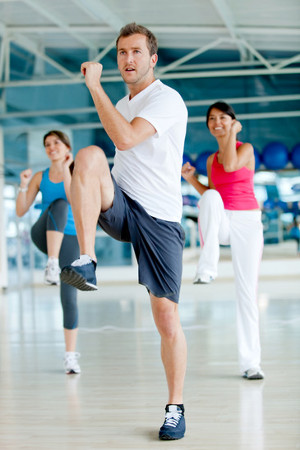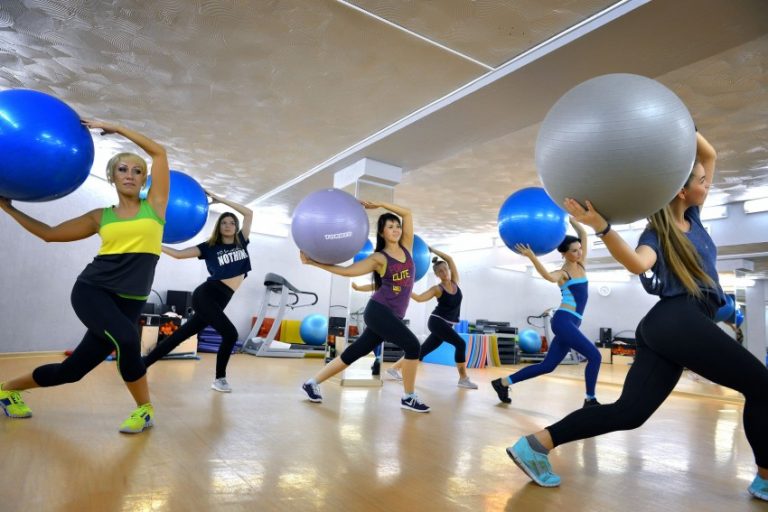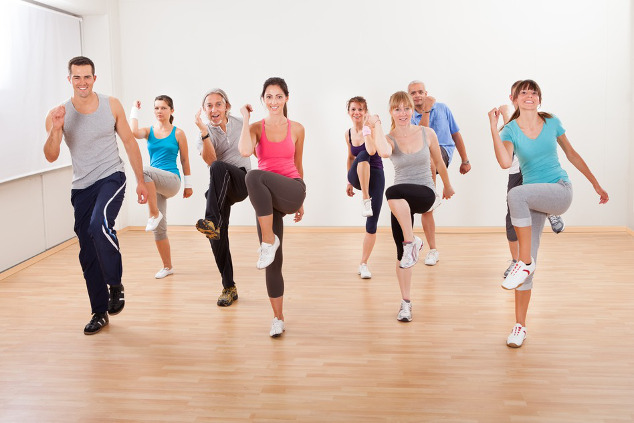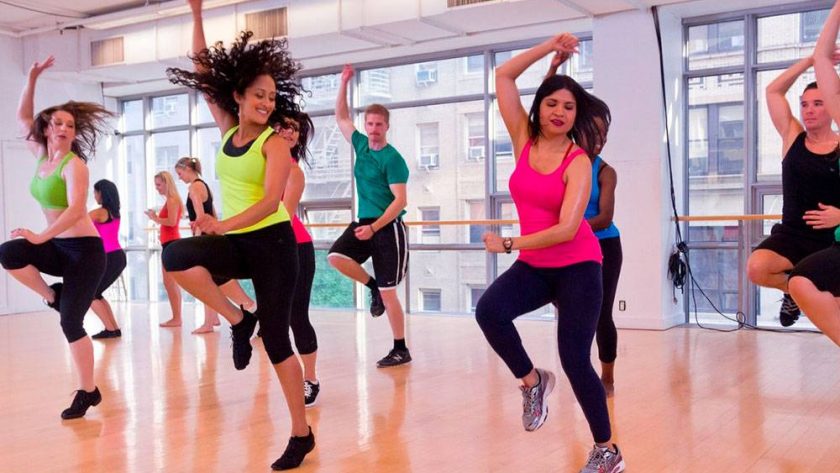In the first part of the series of articles on the topic of aerobics, the different types of aerobics were examined in addition to the definition and methodology. Whether box aerobics, aqua aerobics, dance aerobics or martial arts aerobics – various forms and sub-forms have developed from classic aerobic training, which in turn set their own priorities and training goals .
Aerobic: What is being trained?
Aerobics is a dynamic fitness training that trains aerobic endurance or fitness as well as coordination in its basic elements.
Training goals in aerobics are to improve strength, endurance, flexibility and coordination. Thanks to the numerous types of aerobics, training and exercises can be made extremely varied. Depending on personal preference, e.g.
Elements from different dances or martial arts can be included, various aids are used or certain muscle groups are specifically strengthened.
Increase endurance with aerobics

If pure endurance sports such as jogging, cycling and swimming are too boring, aerobics is the right place for you!
The increase in aerobic endurance is a central training goal. But what exactly is “aerobic endurance”?
The terms aerobic / anaerobic endurance describe two types of muscular energy supply. The question is: How does the organism provide the energy necessary to maintain a certain intensity of exercise (e.g. aerobic tempo)?
In short: If the necessary energy is largely provided by oxidation with oxygen, one speaks of aerobic endurance .
With a higher intensity of exertion, it may be that so much energy is required that the oxygen provided by breathing is no longer sufficient to cover the increased energy requirement.
In this case, the body has to enter a oxygen deficit in order to maintain the exercise intensity. He is practically forced to gain part of the required energy without oxygen (anaerobically) .
During aerobic training, the body usually has to do not owe oxygen. The exercise intensity tends to be constant, so that aerobics is about maintaining a certain exercise intensity over a longer period of time .
Improve your stamina with aerobics
Aerobics is an excellent fitness training with which stamina can be built up or also significantly increased. Condition is not to be equated with endurance, but rather it is made up of the factors strength, speed, endurance and flexibility.
A distinction can be made between two methods of improving fitness with aerobic training: The continuous method and the interval method .
The long-term method: developing endurance
With the long-term method, the exercise intensity remains constant, i.e. constant during the entire load period. The training time ranges from 30 minutes to several hours. Short training units do not provide for breaks; breaks are only allowed for longer periods of several hours.
The exposure with this method is quite low and must not exceed the “anaerobic threshold” . The anaerobic threshold describes the highest possible exercise intensity that an athlete can just achieve while maintaining a balance between the formation and breakdown of lactate.
Endurance performance below the anaerobic threshold can be maintained for a very long time. Stress at the anaerobic threshold (just above / below) are the maximum stress that can be sustained over the long term, with a drop in performance after 60 to 90 minutes with intensive continuous work. On the other hand, performances above the anaerobic threshold can only be sustained for a short time or for a few minutes.
Since the body is exposed to a certain load over a longer period of time with the permanent method, the load should be kept low. Otherwise the body would tire too quickly so that he would not be able to endure longer endurance sessions.
The permanent method is particularly suitable for developing endurance performance or Basic perseverance. It is suitable for beginners and untrained as well as for competitive athletes at the beginning and during the season.
In addition to improving endurance, the long-term method stimulates fat burning, improves the circulatory and respiratory system and stabilizes the nervous system. The effect depends primarily on the duration and, secondly, on the intensity.

The interval method: improve aerobic endurance
In contrast to the continuous method, the load with the interval method is not continuous, but at intervals . The training alternates between stress exercises and breaks.
The duration depends on the sport. In aerobics, the intense stress phases first last 15 to 60 seconds, then 1 to 8 minutes or 8 to 15 minutes. The exercise intensity in the interval method is basically on the aerobic-anaerobic threshold . It ranges from the upper range of basic endurance to the upper aerobic-anaerobic transition range.
The breaks are chosen so that they do not lead to complete recovery, but only about two-thirds of the way to recover.
The principle is also called “worthwhile” breaks . The breaks only last until you feel confident about the same load again. The breaks are “worthwhile” because at this point the body has made the main part of the recovery after the previous exercise.
A further distinction is made between the intensive and the extensive interval method. With the extensive interval method the exercise intensity is in the lower range of the interval methods (between 60 and 80 percent of the maximum heart rate). The aim of the training is to improve aerobic endurance .
Intensive interval methods are used to improve the aerobic-anaereobic energy supply , but primarily to improve the ability to recover and lactate tolerance. The exercise intensity is between 80 and 90 percent.
The goal of interval training is to increase the depth of exhaustion and the effectiveness of the training stimulus.
long method vs. Interval method
As with many other sports, the continuous or interval method can also be used for aerobic training. The aerobics courses offered range from training units with constant stress intensity and without breaks to high-intensity aerobics interval training .
Promote coordination with aerobics
In addition to physical fitness, aerobic training also trains coordination . The level of coordinative skills depends on the one hand on the natural disposition and on the other hand on the individual level of training. The coordinative abilities in different sports and physical demands can also be different.
The type and scope of the coordinative skills required in aerobics result from the structure of the respective movement . The higher the number of components and the greater the difficulty of bringing them together, the more complex or difficult the movement and its dynamics.
The coordination is made up of the most varied of human abilities. Depending on the aerobic exercise, the following coordinative skills are required:
- Sense of balance: Ability to keep balance (e.g. with one leg on the stepper)
- Balance ability: Balance ability or ability to keep balance during and after extensive body shifts
- Orientation ability: Ability to change the position and movement of the body in space (e.g. jumping maneuvers and turns) in a targeted manner
- Coupling of movements: Ability to combine several partial body movements into an orderly sequence of movements
- Movement harmony: Ability to perform aerobic movements in a harmonious sequence
- Ability to create rhythm: Ability to adapt to an external rhythm (e.g. the beat of the music) and to translate it into movement
- Adaptability: Ability to adapt to e.g. to adapt new steps and sequences of movements, different speed or different rhythm
- Responsiveness: Ability to react to stimuli such as the instructions and instructions of the aerobic trainer or music
- Ability to anticipate: Ability to mentally anticipate a future sequence of movements
- Combination ability: Ability to link several movement units to form a closed movement sequence
- Ability to control: Ability to precisely shape one’s movements
- Skill: Ability to carry out the steps as precisely as possible (exactly, exactly), without great effort and quickly
- Flexibility: Ability to perform physical movements with a certain range of oscillation (flexibility, flexibility, agility)
Aerobics combines endurance training with dance and rhythmic movement and thus trains coordination in a special way. Those who are not into dancing will find various aerobics variants with ball and martial arts elements, in which athletic movements are practiced to motivating music.
Aerobic steps: Low Impact vs. High Impact
The aerobic step patterns are divided into two categories, depending on the intensity: Low Impact and High Impact.
Low-impact means “low impact”, more precisely low impact load . Basic low-impact steps are similar to normal walking movements, in which one foot is always in contact with the ground and the other foot gently touches down.

Because of the low intensity of exercise, low-impact steps in aerobics are particularly gentle on the joints. In addition, the relatively low physical strain is ideal for people with overweight, back problems, etc.
With the multitude of aerobic variants, there are significantly more basic steps with low impact . Here are some examples:
While the aerobic steps in the Low Impact have a low impact force, the impact load in the High Impact is significantly greater.
High impact translates as “high impact” . In contrast to the low-impact variant, where one foot is always in contact with the ground, the step pattern in the high-impact version ensures that both feet lose traction for a short time. Many aerobic steps are jumped.
Due to the high level of exposure, there are no pure high-impact aerobics courses to be found in practice. Most of the time, high-impact steps are combined with low-impact step patterns and put together into a common, balanced choreography. One then speaks of the “Mixed Impact” .
Although the low-impact steps in an aerobic workout are associated with greater stress, the aerobic trainers ensure that the movements are carried out in a health-promoting manner in order to protect the joints .
The following table shows some examples of high-impact basic steps in aerobics , which – compared to low-impact steps – are much more manageable:
The more high-impact steps the aerobic training includes, the more strenuous it becomes.
conclusion
Aerobics offers diverse training methods and step sequences so that training can be optimally adapted to individual fitness and personal training goals.
In particular the endurance, stamina and coordination can be significantly improved with aerobics. Whether as a permanent method or interval method, with low-impact or high-impact steps – aerobics offers different options for making training successful!
Almost every gym now offers this mixture of fitness and conditioning training. For beginners, basic endurance training is usually offered, in which the basic aerobics steps are in the foreground and are combined into easy choreographies .
For everyone who would like to do intensive endurance training, there are special aerobics courses with higher training intensities . Advanced students can also take aerobics courses with complicated choreographies and difficult step sequences.
Tip: Just go to the gym around the corner to find out which aerobics classes are on offer! It is also best to inform about the requirements and training goals .
Not every aerobic exercise is equally suitable for everyone. Intensive aerobic workouts in particular are less suitable for people with high blood pressure, overweight, knee or back problems.
It’s best to get advice beforehand! Then aerobics also becomes motivating full-body training that promotes endurance, coordination and weight loss!



